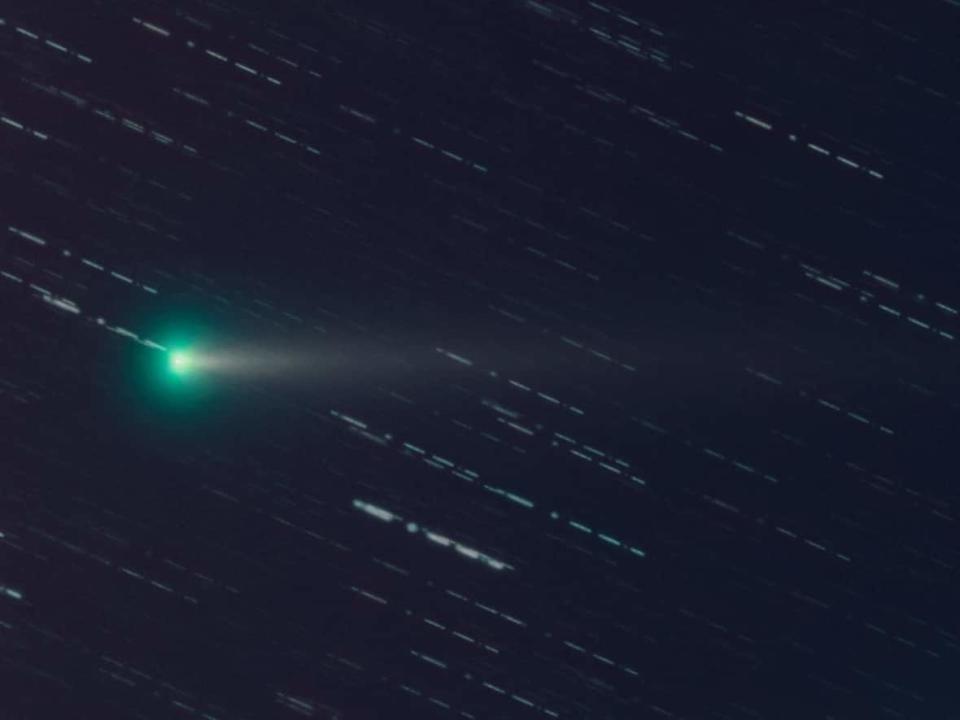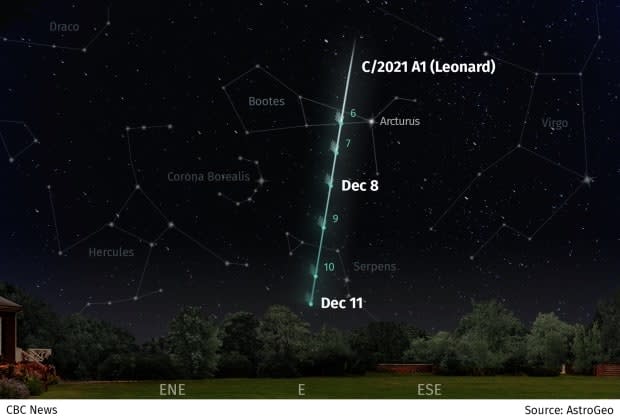How to catch your once-in-a-lifetime look at Comet Leonard

Your once-in-a-lifetime chance to see a green comet named C/2021 A1 — a.k.a. Leonard — is here. Astronomy experts, including the comet's discoverer, offer tips on when and how to see the comet.
What is Comet C/2021 A1?
Like other comets, Leonard is a ball of frozen gas, rocks and dust. When its orbit brings it close to the sun, the heat causes some of that material to vapourize, which makes it glow and sprout a tail of gas and dust.
Why is this comet causing so much excitement?
While many comets pass through our solar system, few come close enough to the sun or the Earth for us to see them.
This week, it may be possible to see Leonard even without binoculars, the experts said.
"Brighter comets are rare, so it's definitely worth making an effort to see them," said Chris Vaughan, an operator at the David Dunlap Observatory in Richmond Hill, Ont., and a volunteer with the Royal Astronomical Society of Canada. Vaughan recently posted about Comet Leonard on his Astronomy Skylights blog.
Leonard's discoverer, Greg Leonard, has discovered 13 comets, but said this one feels "like hitting the celestial jackpot," because of how visible it will be.
"It's a real dream come true and it's very, very humbling," he told CBC's As It Happens on Dec. 2.
When is the best time to see the comet?
Right now, the comet is visible in the Northern Hemisphere in the eastern sky to people using binoculars from anywhere in Canada in the early morning, he said.
It's expected to get brighter and closer to the horizon every morning until Saturday, Dec. 11.
For those who want to see the comet, Vaughan recommends going out in the early morning over the next couple of days, if the sky is clear. He said an area away from city lights, with a clear view of the horizon to the east, would offer the best view. By returning on subsequent mornings, you should be able to notice the change, he said.
If the weather co-operates, Friday and Saturday mornings around 6 a.m. may be the best bets for a good view. At that point, Vaughan said, Leonard should still be high enough that it won't be blocked by trees and houses or distorted by the atmosphere.
On Sunday, Dec. 12, the comet should make its closest approach to Earth, then disappear the next day for Northern Hemisphere viewers.
It's expected to return Monday after sunset, as it heads away from the Earth toward the sun, getting fainter over the following weeks.
"But it'll never get very high above the horizon," Vaughan said. "The pre-dawn is your best chance [for viewing], the next few days."
How can you find it in the night sky?
It will be in the eastern sky below and to the left of the bright star Arcturus in the constellation Bootes.

Justin Anderson, an astrophotographer who lives north of Brandon, Man., managed to capture the comet earlier this week, and said he plans to keep going out to take more photos.
He said he uses mobile apps such as Star Walk and Stellarium that allow you to point your phone up at the sky, show a map of the stars in that region and pinpoint where the comet is expected to be.
"With binoculars, it was pretty difficult to find it, just because the tail is quite dim," Anderson said.
It's easier to find with a camera, he said, which is more sensitive to faint objects than our eyes. The camera doesn't need to be fancy, Anderson said, although zooming in may help.
"Put your camera in that direction and take a photo if you don't see it," he said. "You might have to move it a little bit more and take another photo until you do see it. But it is very green on the camera, and you do see a little bit of a tail behind it."
When will it become visible to the naked eye?
As of Dec. 7, Leonard was 46.25 million kilometres away, with a brightness magnitude of 6.9. It will need to reach a magnitude between four and five to be visible in rural areas, Vaughan said,which it is predicted to do this weekend.
The @cometleonard Twitter account provides regular updates on the comet's magnitude.
Magnitude five is dimmer than last year's Comet NEOWISE, which topped out between magnitude one and two, similar to the North Star, Polaris.
But no one knows if Comet Leonard will follow predictions.
"The only thing consistent about comets is their unpredictability," said Greg Leonard. "And a famous comet hunter once said comets are like cats. Both have tails and both do precisely what they want."
Where did Comet Leonard get its name?
Comets are generally named after their discoverers. Greg Leonard works for the NASA-funded Catalina Sky Survey at the University of Arizona in Tucson, hunting and tracking near-Earth asteroids.
"On occasion, we stumble into an unknown comet," he told CBC.
This is actually not the only Comet Leonard. Greg Leonard has discovered 12 other comets — all called Leonard.
But they all have different years, letters and numbers attached.

On Jan. 3, C/2021 A1 became the first comet discovered this year. The "A" means it was found in the first half of January.
Why do we only get one chance to see it?
Comet Leonard is expected to pass by once and never again.
The comet formed about 4.5 billion years ago and comes from about 550 billion kilometres away, or 3,700 times the distance between the sun and the Earth.
"It's been inbound toward the inner solar system for the past 35,000 years," Leonard said.
It's zooming through space at 70 kilometres per second, he said. "That's enough speed for it to get flung away from our solar system."
It may arrive in some other star system millions and millions of years from now.
In the meantime, "just appreciate that this beautiful celestial object is up in the sky," Leonard said.
"I sure wish everybody clear skies and the opportunity to have a look and see it for themselves."

 Yahoo Finance
Yahoo Finance 